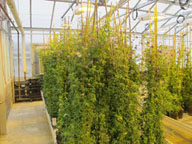
As Northern New York farmers begin checking their fields for signs of brown root rot (BRR) this spring, Cornell University researchers are preparing to overcome a weather-related setback to developing regionally-adapted alfalfa varieties resistant to the soil-borne fungus Phoma sclerotioides.
Ice sheeting in 2012 killed both older and younger generations of alfalfa plants and caused the loss of significant data from the field trials at the William H. Miner Agricultural Research Institute at Chazy, NY.
Since 2008 with funding from the farmer-driven Northern New York Agricultural Development Program, Cornell researchers have managed a trial to test the resistance to BRR in currently available alfalfa varieties.
Cornell plant breeders Don Viands and Julie L. Hansen are hoping an agronomist’s loss will become a plant breeder’s gain in that the trial results were lost to winterkill, but the surviving plants may be genetically improved for winter stress, perhaps including resistance to BRR.
In 2013, the research group grew out stem cuttings from surviving plants from Cornell-developed alfalfa varieties. Seed was produced and is now ready for planting at Chazy in the 2014 BRR-resistance trials on a field with a high concentration of BRR.
BRR-resistant alfalfa grown in the Canadian province of Saskatchewan, where BRR has been a long-term problem for alfalfa production, has shown up to 65 percent higher yields, however, says Cornell Plant Pathologist Gary C. Bergstrom, “Unfortunately for New York alfalfa growers, the BRR-resistant variety that does well in Saskatchewan and Alberta performs poorly here as it is susceptible to other alfalfa root rots common in New York.”
Brown root rot was first identified in the eastern United States in Clinton County in northern New York in 2003. It has since been confirmed in Vermont, New Hampshire, Maine, and Ontario. The fungus impacts alfalfa, other perennial legume crops, and overwintering grass crops. BRR persists in soil year-round, becoming primarily active in winter and early spring, causing slow crop emergence, stand decline, and yield loss.
The latest Brown Root Rot of Alfalfa: Challenges and Opportunities research report is posted in the Field Crops section on this website.